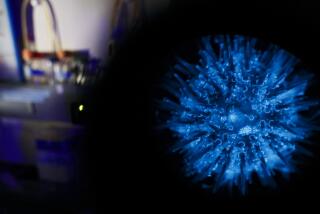Mice Are Glowing Green to Help Chemotherapy Patients
Tattoos, tooth jewelry, tongue-piercings ... in a decade or so, teenagers (and their fuddy-duddy parents) may have yet another tool for self-expression--hair that’s genetically engineered to glow green, yellow, blue, red or all of the above, in cunning designs.
Under normal lighting conditions (say, when Aunt Milly comes to visit), Janey or Jonny’s hair could look conservatively brown or black. But under a gentle blue light, chemicals artificially engineered into Jane and Jon’s hair shafts would cause the shafts to brightly fluoresce.
This hip scenario already exists in the rodent world. Mice whose skin glows green from tip of tail to end of snout--handy for certain experiments--can be purchased from the Jackson Laboratory in Bar Harbor, Maine, purveyors of fine mice, but only by scientists with legitimate research purposes. (So you can forget about ordering green, glowing mice for your Halloween bash.)
And, according to a recent article in the scholarly Proceedings of the National Academy of Sciences, mice with green fur also are scampering around in labs.
Robert Hoffman, president of San Diego’s AntiCancer Inc. (the company that made the green-furred mice), says the creatures aren’t green all over, nor spotted exactly--more variegated. Here’s how they got that way.
First, bits of skin were removed from the mice and treated with an enzyme to loosen them up.
Next, a jellyfish gene inserted into a harmless virus was added to the brew. If the gene successfully entered the genomes of hair-producing cells, that soon became very apparent. The gene, which directs formation of a fluorescent protein, causes hairs and their follicles to gleam green under the right kind of light.
Final step: Transplant the glowing skin back onto the mice.
What, we asked Hoffman, is the point of all this? To create zany, designer pets for the rich, famous and twisted?
Hoffman says he has no problem with people one day genetically altering their scalps for cosmetic reasons: “What the heck, I’d rather see people use a safe gene than toxic hair dyes,” he says.
But, as the name of the company suggests, that isn’t AntiCancer’s purpose. Instead it’s to learn how to stop hair from falling out during cancer chemotherapy.
Green hair, in fact, was created only for convenience. The scientists are trying to figure out how to insert genes efficiently into hair follicles--and a bright, eerie glow just happens to be an in-your-face, can’t-be-missed sign that a gene was successfully inserted.
Now Hoffman and colleagues plan to sift through the human genome to find ones that might help hair grow back again and insert those into hair cells.
They are not, moreover, uninterested in other types of hair loss--such as male pattern baldness. Men go bald when their hair follicles respond to male hormones and transmogrify into a different kind of follicle (the kind we have on less hairy parts of our bodies). What if there was a way to insert genes to transmogrify them right back again? “Everyone who works on hair biology has an eye on that goal,” Hoffman says.
Hoffman even dreams of engineering hair follicles into veritable factories of important medical chemicals that could be pumped into the bloodstream to treat disease. After all, the hair-producing cells are productive.
“Think of it: a meter-long hair shaft coming out of a tiny little follicle,” he exalts. “Now instead of making a beautiful hair on a lady, imagine making a protein that cures diabetes, Parkinson’s, cancer.”
A whole pile of work needs doing before such dreams can transpire--like making sure that the genes are turned on good and strong; that they stay turned on good and strong; figuring out how to get DNA efficiently into follicles by applying it directly to a head (which would be nicer than having bits of one’s skin taken off)--and last, but certainly not least, that the therapy is safe.
If all that’s done, hair color changes could feasibly follow, Hoffman speculates--and the palette of possible hues only stands to increase. Already, scientists have figured out a way to modify the jellyfish protein so it glows yellow or blue. Another protein--this one from a coral--glows red. They’re searching for even more colors among the luridly colored fish, polyps and other creatures dwelling in the tropical reefs of the world.
The look would be fabulous--and we’d never have to touch up our roots.
*
If you have an idea for a Booster Shots topic, write or e-mail Rosie Mestel at the Los Angeles Times, 202 W. 1st. St., Los Angeles, CA 90012, rosie.mestel@latimes.com.





